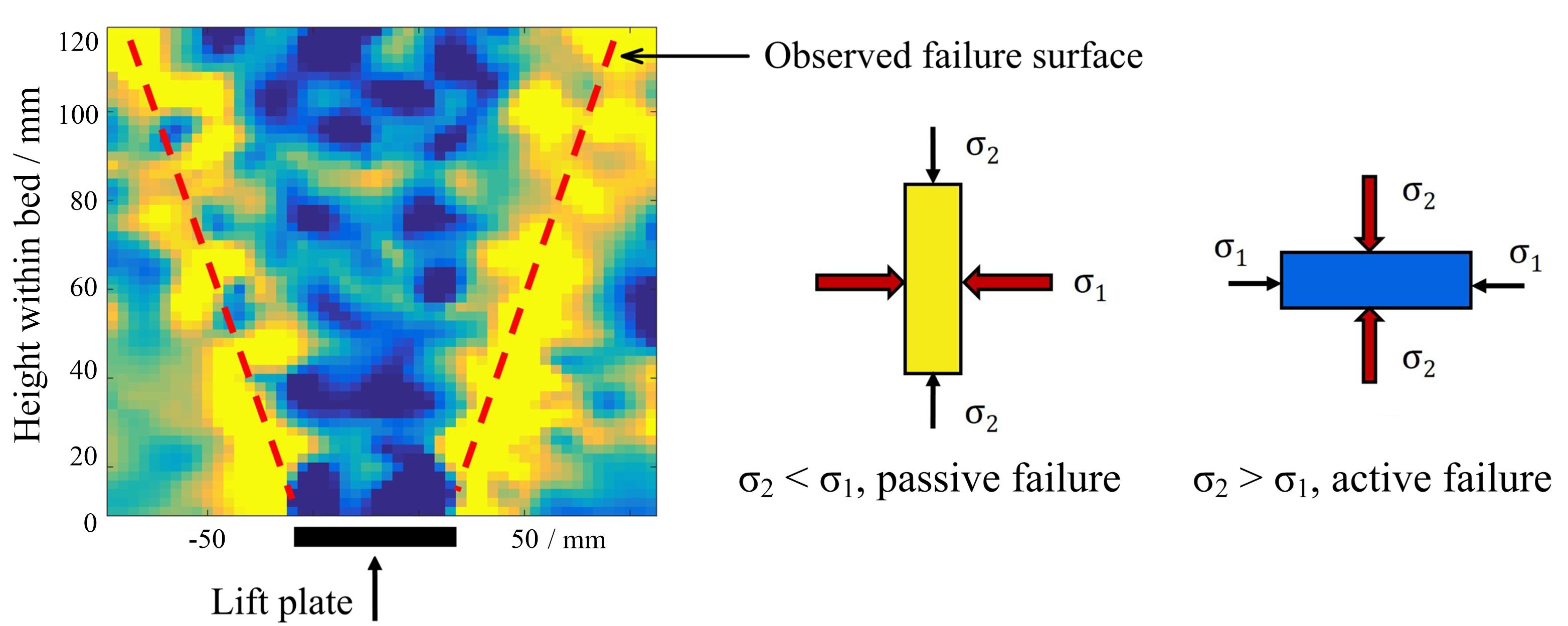Technical Report 232, c4e-Preprint Series, Cambridge
Lifting an object buried in granular material; experiments and theory
Reference: Technical Report 232, c4e-Preprint Series, Cambridge, 2019
- Experiments performed on ballotini contained between two vertical glass plates.
- Force to lift a buried horizontal plate measured as a function of displacement.
- Particle imaging used to observe slip planes and failure mode of ballotini.
- Passive failure near slip planes; active failure between slip planes.
- Reverse Hopper Theory predicts uplift force and angle of slip planes.
 The paper describes experiments and theory relating to particle movements when a horizontal plate, buried in granular material, is lifted. The experiments were quasi two-dimensional. Glass ballotini were contained between two vertical glass plates separated by a distance of 24 mm. A buried horizontal rectangular plate, 24 mm x 45 or 60 mm was lifted vertically, giving two slip planes starting from the edges of the plate; the slip planes were inclined at angles ±α to the vertical. The measured lift force increased steeply with upward displacement, reaching a maximum after a small displacement. Further movement caused a fall in lift force, as observed by many authors. A novelty in this work was to measure the motion of individual particles: the movements showed clearly that near the vertical centre line, there was ‘active’ failure, i.e. (vertical stress) > (horizontal stress). Near the failure surfaces, at angles ±α to the vertical, there was ‘passive’ failure. Outside the failure zones the stresses were isotropic (equal stresses vertically and horizontally). On the basis of these observations, the ‘reverse hopper’ theory was developed; the theory assumes active failure near the vertical centre line. It predicts the dimensionless peak lift force Nqf and the angle a, in reasonable agreement with the rather scattered data from the experiments. The existence of well-defined slip planes is equivocal, as suggested by the experimental techniques employed, as follows:
(i) A photographic technique registered black for a particle that moved more than a threshold quantity; particles with smaller movements registered white. Results show clearly defined slip planes.
(ii) Observations of individual particles showed movement profiles with significant movement in the middle of the failure zone, but falling off gradually with distance from the vertical centre line. This suggests that the existence of slip planes is equivocal; a threshold value of particle movement had to be identified to define a slip plane.
The paper describes experiments and theory relating to particle movements when a horizontal plate, buried in granular material, is lifted. The experiments were quasi two-dimensional. Glass ballotini were contained between two vertical glass plates separated by a distance of 24 mm. A buried horizontal rectangular plate, 24 mm x 45 or 60 mm was lifted vertically, giving two slip planes starting from the edges of the plate; the slip planes were inclined at angles ±α to the vertical. The measured lift force increased steeply with upward displacement, reaching a maximum after a small displacement. Further movement caused a fall in lift force, as observed by many authors. A novelty in this work was to measure the motion of individual particles: the movements showed clearly that near the vertical centre line, there was ‘active’ failure, i.e. (vertical stress) > (horizontal stress). Near the failure surfaces, at angles ±α to the vertical, there was ‘passive’ failure. Outside the failure zones the stresses were isotropic (equal stresses vertically and horizontally). On the basis of these observations, the ‘reverse hopper’ theory was developed; the theory assumes active failure near the vertical centre line. It predicts the dimensionless peak lift force Nqf and the angle a, in reasonable agreement with the rather scattered data from the experiments. The existence of well-defined slip planes is equivocal, as suggested by the experimental techniques employed, as follows:
(i) A photographic technique registered black for a particle that moved more than a threshold quantity; particles with smaller movements registered white. Results show clearly defined slip planes.
(ii) Observations of individual particles showed movement profiles with significant movement in the middle of the failure zone, but falling off gradually with distance from the vertical centre line. This suggests that the existence of slip planes is equivocal; a threshold value of particle movement had to be identified to define a slip plane.
PDF (6.0 MB)



